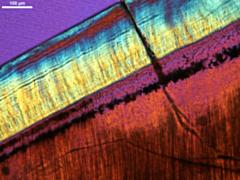Project 3543: M. R. Whitney, C. A. Sidor. 2019. Histological and developmental insights into the herbivorous dentition of tapinocephalid therapsids. PLOS ONE. 14 (10):e0223860.
Abstract
Tapinocephalids were one of the earliest therapsid clades to evolve herbivory. In acquiring derived tooth-to-tooth occlusion by means of an exaggerated heel and talon crown morphology, members of this family have long been considered herbivorous, yet little work has been done to describe their dentition. Given the early occurrence of this clade and their acquisition of a dentition with several derived features, tapinocephalids serve as an important clade in understanding adaptations to herbivory as well as macroevolutionary patterns of dental trait acquisition. Here we describe the histology of tapinocephalid jaws and incisors to assess adaptations to herbivory. Our results yield new dental characters for tapinocephalids including a peculiar enamel structure and reduced enamel deposition on the occlusal surface. These traits are convergent with other specialized herbivorous dentitions like those found in ornithischian dinosaurs and ungulates. Furthermore, these results demonstrate that while acquiring some specializations, tapinocephalids also retained plesiomorphic traits like alternate, continuous replacement. We interpret these findings as an example of how different combinations of traits can facilitate a derived and specialized dentition and then discuss their implications in the acquisition of a mammal-like dentition.Read the article »
Article DOI: 10.1371/journal.pone.0223860
Project DOI: 10.7934/P3543, http://dx.doi.org/10.7934/P3543
| This project contains |
|---|
Download Project SDD File |
Currently Viewing:
MorphoBank Project 3543
MorphoBank Project 3543
- Creation Date:
02 October 2019 - Publication Date:
30 December 2019 - Media downloads: 1

This research
supported by
Authors' Institutions ![]()
- Burke Museum of Natural History and Culture, Seattle
- University of Washington

